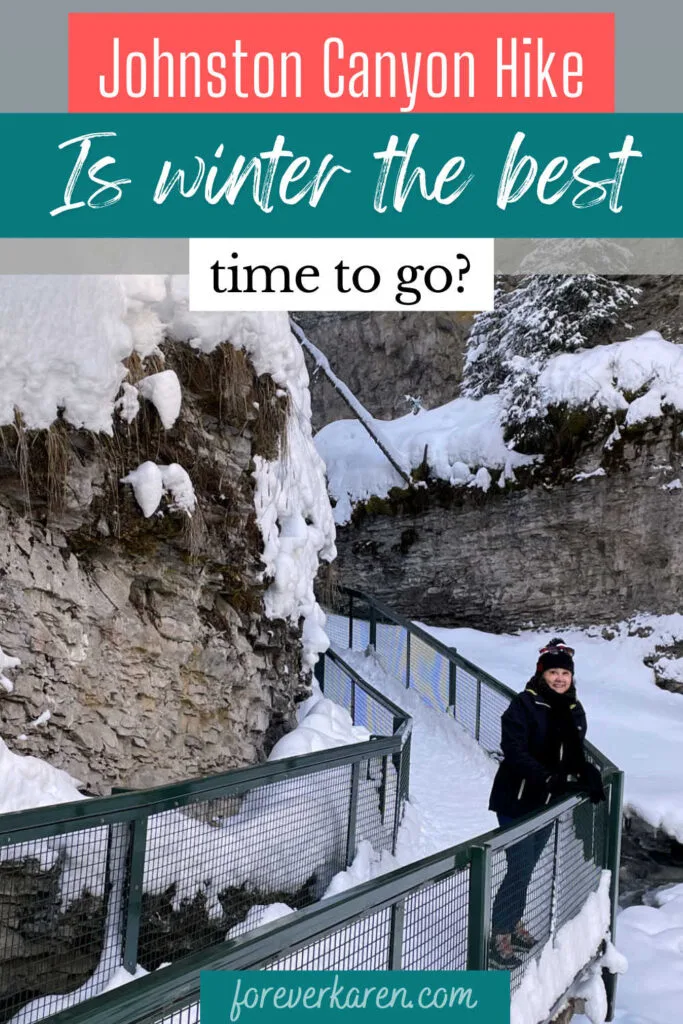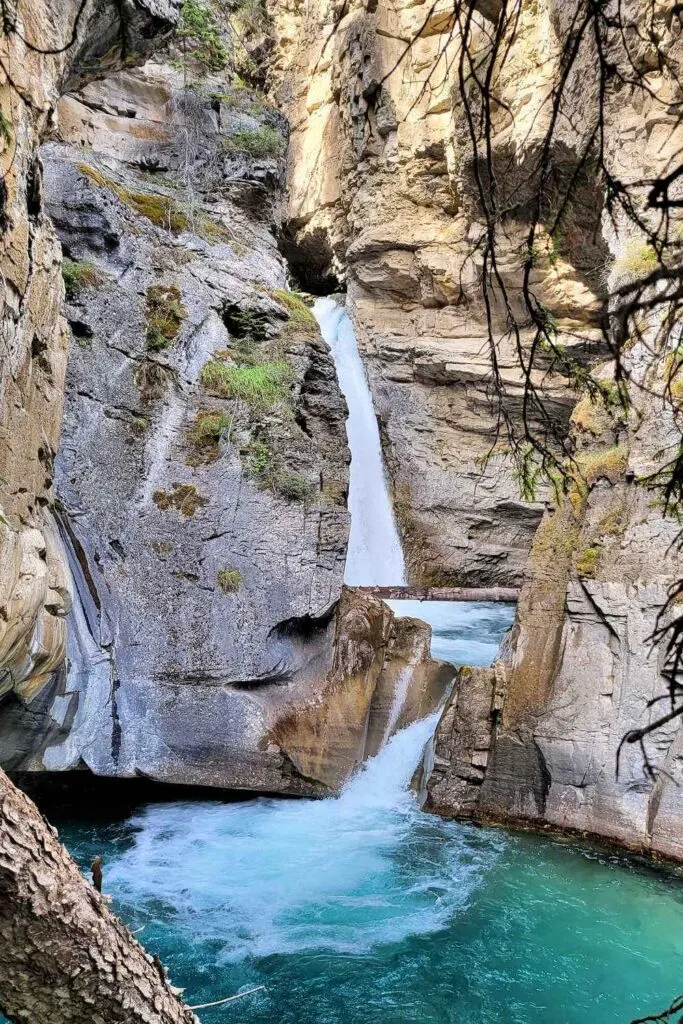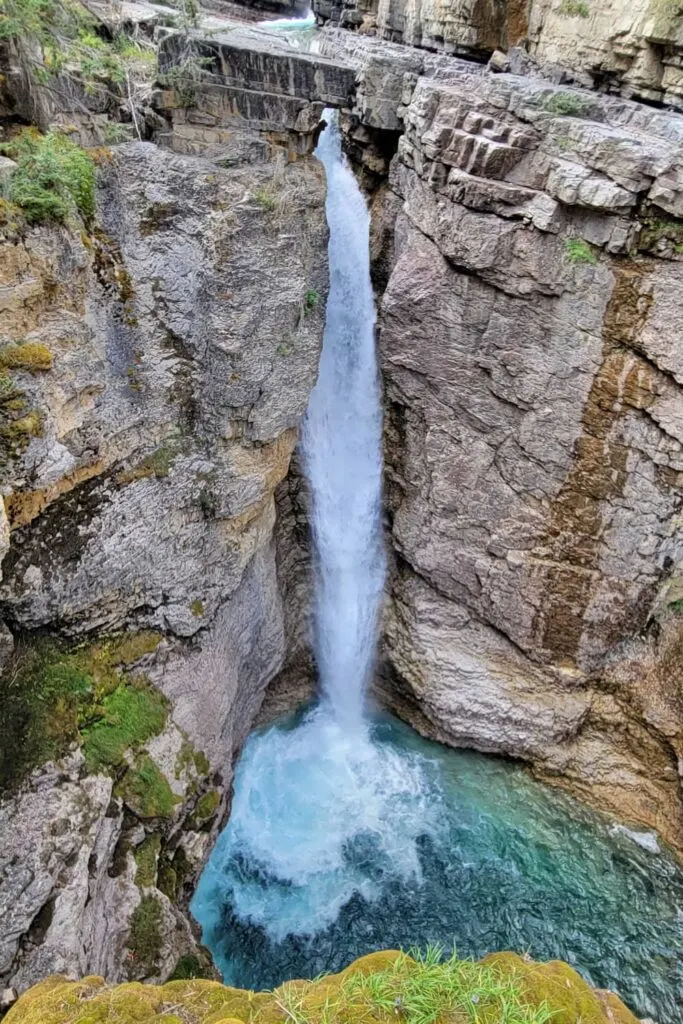
Located in Banff National Park, Johnston Canyon is arguably Banff’s most popular waterfall hike. The out and back trail allows hikers to walk as far as they like, and the pathway is suitable for children, those without hiking experience, and walkers with dogs.
During the summer months, the hike attracts crowds to the point that parking becomes a problem. However, the trail allows hikers to experience a winter wonderland when parts of the river become frozen in winter.
Once the waterfall has completely frozen, tour groups offer ice climbing in Johnston Canyon.
Is hiking Johnston Canyon in winter the best time to go with an empty parking lot, few people, and snow everywhere you look?
How To Get To Johnston Canyon?
While Banff offers many great winter activities, hiking Johnston Canyon should be top of your list. To get to Johnston Canyon from Calgary or Banff, travel west on the TransCanada Highway/AB-1, and take the Bow Valley Parkway exit.
From Lake Louise, take the Castle Junction exit from the main highway and travel east to Johnston Canyon. The drive from Banff or Lake Louise should take 30 minutes but may take longer in winter when packed snow covers the road.
It’s free to hike the Banff canyon and open year-round, although you need a Discovery Pass. In summer, the lineup for the parking lot was long, but we were fortunate to get a spot relatively quickly.
During busy times, the parking lot closes to vehicles, creating a bottleneck in the area. Regardless of how busy it gets, hiking Johnston Canyon is a must for every Banff itinerary.
In winter, the parking lot was mostly empty, with about 25 cars parked, before we arrived. WOW, it was like parking lot heaven! However, in the off-season, the park rangers do not patrol the lot or have park personnel with information at the start of the trail.
For those staying in Banff, the Roam Transit Route 9 shuttle takes visitors from Banff to Johnston Canyon daily, from May until October. In winter, you’ll need your own vehicle.
Johnston Canyon History

In the late 1800s, a prospector named Johnston came to the creek searching for gold. While he never discovered any gold during his panning excursions, the Canyon now bears his name.
Twenty-five years later, a teahouse and series of log cabins were built at the entrance to Johnston Canyon as tourism attracted the wealthy. In 1916, Walter Camp and his wife, Marguerite, purchased the property.
Through years of exploration, Walter discovered at least six waterfalls on the creek, one of which he named after his wife, Marguerite. He blazed a pony trail and offered tours to the Upper Falls and interpretive talks on the canyon.
After Walter’s passing in the 1970s, Parks Canada approached the Camp family to develop the canyon. In 1980, the seven makeshift bridges were replaced with steel suspended catwalks, making it safe to visit. Shortly after that, I made my first visit to Johnston Canyon in 1983.
Preparing For Your Hike
I’ve hiked Johnston Canyon multiple times over a thirty-five-year period. But I recently experienced it in summer, and three months later in winter. The difference was like night and day.
During warm weather, the Market Café and “the shack” provide hikers with a place to grab drinks or a snack before the trek. In the winter, these venues are closed, so be prepared by bringing a travel mug with a hot beverage.
The hike begins at the parking lot’s north end, crosses a bridge, and turns right. Before the bridge, visitors have access to heated washrooms with flush toilets. During my visit to Banff in the fall, the narrow canyon walls were so crowded that a sign recommended facial masks at the start of the trail.
With some parts of the pathway only allowing one person, it was impossible to social distance. Although crowded, hikers were very accommodating at waiting and allowing groups to pass.
Fast forward three months, and the trail was empty, providing a peaceful adventure. We could take photos without holding up a line and not have to wait on the walkways to pass. While still walked regularly, the trail consisted of packed snow, and thick powder blanketed the trees.
Johnston Canyon Hike Distance
Most hikers consider Johnston Canyon a leisurely walk with minimal elevation gain, depending on how far you go. The majority of visitors go to either the Lower or Upper Falls. Some trek to the Upper Falls in everyday runners, but we recommend hiking boots with ankle support.
| JOHNSTON CANYON to the: | DISTANCE (round-trip) | ELEVATION GAIN |
| Lower Falls | 2.3 km | 100 meters |
| Upper Falls | 5.1 km | 260 meters |
| Ink Pots | 11.7 km | 600 meters |
Although well-traveled in winter, the small sloping pathway becomes slick in some areas. I’d highly recommend crampons and hiking poles to prevent slipping.
In December, the trail to the Upper Falls was easy, and the snow well-packed. However, beyond that, the snow was much deeper as fewer trekkers had continued to the Ink Pots. If you plan to see the Ink Pots in winter, you’ll need snowshoes and trekking poles.
Johnston Canyon Scenery
Anyone who has hiked Johnston Canyon will tell you that the scenery is spectacular. While the trail recognizes two waterfalls, “Lower Falls” and “Upper Falls,” Johnston Canyon has many smaller ones. Most of these waterfalls are frozen in winter, with small flowing waterways underneath.
Once you’ve crossed the river from the parking lot, the trail follows the left side of Johnston Creek. At first, it’s a reasonably wide path but soon narrows. With steep drop-offs, a metal railing prevents falls and provides support on slippery sections in winter.

As the canyon narrows, hikers continue on a catwalk suspended from the rock. It’s a marvel of engineering to see how the park created this incredible canyon walk.
With almost perpendicular rock walls and plenty of evergreen trees, the landscape provides good shelter, should it rain or snow.
While some might avoid a trip to the popular Banff canyon because it’s too touristy, consider doing the trail in winter. The never-ending icy waterfalls, stunning snow-filled trees, and glimpses of snow-capped peaks between the trees are everywhere.
Along the route, Parks Canada has built many benches when you need to rest, although these were covered in thick snow in winter. The scenery in winter far exceeded our summer trek three months earlier.

I compare hiking Johnston Canyon to exploring an antique store. You never know what treasures you’ll discover around the next corner. In September, the canyon was lush with cushioning moss, and the gorge was alive with the sweet sounds of running water and cheerful songbirds.
In high contrast, winter brought a golden silence.
Hiking To The Lower Falls
The majority of hikers use the Lower Falls as their turnaround point. This area becomes a bottleneck during peak times as selfie enthusiasts queue along the bridge to view the falls.

The narrow bridge crosses the creek, and the trail disappears inside a dark tunnel. At the end of the tunnel, a platform offers close views of the falls. In summer, be prepared to get wet from the spray.
This viewpoint is tiny, and only one family or couple should enter to comply with social distancing. With a long queue to reach this lookout in September, we decided not to wait and proceeded to the Upper Falls instead.
The bridge (not the cave) offers the best vantage point for seeing the waterfall during the summer. With no crowds in December, we could go into the cave and see the falls from the cramped space.

It was hard to get up and down the stairs without slipping on the packed snow and ice. With the waterfall mostly frozen, I thought the Lower Falls was more picturesque in winter.
Hiking To The Upper Falls
The trail has more of an incline from the Lower Falls to the Upper Falls. The hike alternates through a forest and on suspended walkways over Johnston Canyon. I found I needed to stop more to catch my breath and get hydrated.
Even for me, the elevated catwalks are a big highlight of the trail, and I’ve done the hike countless times. As the trail has grown in popularity, hikers have strayed off the path, resulting in damaged vegetation, compromising wildlife.
This has been especially hard on the Black Swift, an endangered bird trying to repopulate in a “secret cave.” In response, Parks Canada has designated the unofficial trail as “out of bounds,” from April to November.

The trail has some ups and downs from the Lower Falls to the Upper Falls. There are more stairs, and sections of the canyon are wider. Although not as impressive as the Lower or Upper Falls, another falls, Stella Falls was named after one of the Camp’s daughters.

The Upper Falls are much more impressive than the Lower. The water cascades off the cliff with a higher drop into a pool below. While there are two lookout points, one below and the other above, the lower platform is closed for safety reasons.
Ice Climbing
The Upper Falls is primarily frozen in winter and doesn’t resemble its summertime version. The ice formations along the rock wall are amazing to witness. While they look fragile, ice climbers ascend these ice walls using protective gear and safety ropes.

Waterfall ice climbing is a growing sport, and those up for the challenge can find the best ice climbing in Banff and Canmore. We didn’t see any ice climbers on our afternoon hike. But, if you’re lucky, you might witness some in action.
Hiking In Winter
It can be bitterly cold hiking anywhere in Banff during the winter. We experienced warmer days of -12 Celsius to extreme cold of -29 Celsius during our five days. Before taking a hike, make sure you’ve dressed appropriately in thermal base layers, wool socks, and a down or 3-in-1 winter jacket.
I wore a Columbia 3-in-1 jacket with OMNI-HEAT technology and it served me well for this hike. We were thankful when we returned to our suite at the Banff’s Moose Hotel, that we had a cozy fireplace.
Our most used and loved items were hand warmers and toes warmers, which stayed hot for eight to ten hours. We tried out three different types and preferred the Super Size Hand Warmers because they were larger at keeping our fingers warm.
In winter, it also takes more effort to hike. With extra layers and having to tread in deeper snow, hiking in extreme cold can be exhausting. During our hike, bottled water turned to ice.
So, going forward, we preferred to carry travel mugs with hot tea. Even though there’s no heat in winter to dehydrate you, you still need to rehydrate.
Electronics don’t do well in cold conditions. We opted to leave the digital camera behind and use a cell phone instead if we were hiking for a while. Because we can carry a phone next to our bodies, it would stay warm, preventing it from seizing in cold weather.

From the Upper Falls to the parking lot, those small slopes didn’t seem so small on the way back. While we had crampons, we left them in the car because we didn’t think we’d need them in Johnston Canyon.
Boy, were we wrong! Those summer stairs became slippery slopes or mini ski hills.
While tour companies offer winter hikes or ice climbing in Johnston Canyon, you don’t need a paid tour to visit. Just be aware that in winter, daylight hours are limited. So, be sure to check the sunset time, so you’re not returning in the dark.
Final Thoughts
Most will agree that Johnston Canyon is a special place, regardless of the crowds. Its lush forests, murmuring water, and stunning waterfalls create unforgettable memories in summer.
In winter, the landscape transforms into a picturesque postcard frosted with snow. I loved my winter visit to Johnston Canyon. The peaceful setting, void of people, made me appreciate its natural beauty more.
Happy travels ~ Karen
